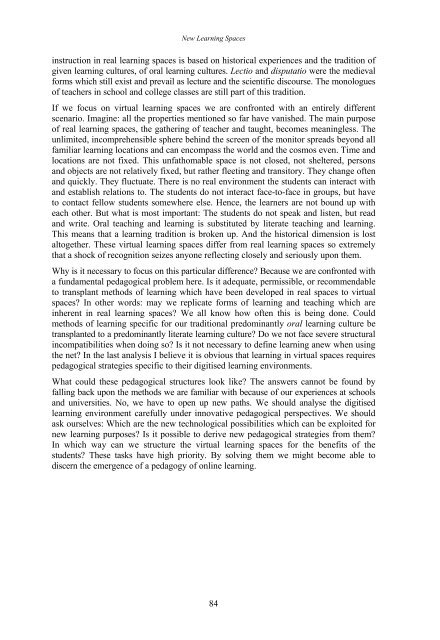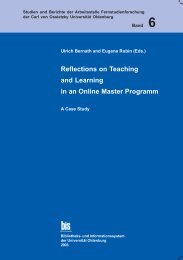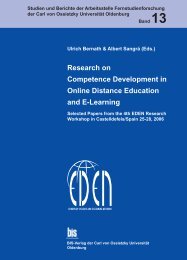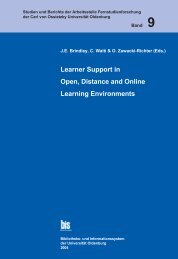Distance Education in Transition - Master of Distance Education ...
Distance Education in Transition - Master of Distance Education ...
Distance Education in Transition - Master of Distance Education ...
Create successful ePaper yourself
Turn your PDF publications into a flip-book with our unique Google optimized e-Paper software.
New Learn<strong>in</strong>g Spaces<br />
<strong>in</strong>struction <strong>in</strong> real learn<strong>in</strong>g spaces is based on historical experiences and the tradition <strong>of</strong><br />
given learn<strong>in</strong>g cultures, <strong>of</strong> oral learn<strong>in</strong>g cultures. Lectio and disputatio were the medieval<br />
forms which still exist and prevail as lecture and the scientific discourse. The monologues<br />
<strong>of</strong> teachers <strong>in</strong> school and college classes are still part <strong>of</strong> this tradition.<br />
If we focus on virtual learn<strong>in</strong>g spaces we are confronted with an entirely different<br />
scenario. Imag<strong>in</strong>e: all the properties mentioned so far have vanished. The ma<strong>in</strong> purpose<br />
<strong>of</strong> real learn<strong>in</strong>g spaces, the gather<strong>in</strong>g <strong>of</strong> teacher and taught, becomes mean<strong>in</strong>gless. The<br />
unlimited, <strong>in</strong>comprehensible sphere beh<strong>in</strong>d the screen <strong>of</strong> the monitor spreads beyond all<br />
familiar learn<strong>in</strong>g locations and can encompass the world and the cosmos even. Time and<br />
locations are not fixed. This unfathomable space is not closed, not sheltered, persons<br />
and objects are not relatively fixed, but rather fleet<strong>in</strong>g and transitory. They change <strong>of</strong>ten<br />
and quickly. They fluctuate. There is no real environment the students can <strong>in</strong>teract with<br />
and establish relations to. The students do not <strong>in</strong>teract face-to-face <strong>in</strong> groups, but have<br />
to contact fellow students somewhere else. Hence, the learners are not bound up with<br />
each other. But what is most important: The students do not speak and listen, but read<br />
and write. Oral teach<strong>in</strong>g and learn<strong>in</strong>g is substituted by literate teach<strong>in</strong>g and learn<strong>in</strong>g.<br />
This means that a learn<strong>in</strong>g tradition is broken up. And the historical dimension is lost<br />
altogether. These virtual learn<strong>in</strong>g spaces differ from real learn<strong>in</strong>g spaces so extremely<br />
that a shock <strong>of</strong> recognition seizes anyone reflect<strong>in</strong>g closely and seriously upon them.<br />
Why is it necessary to focus on this particular difference? Because we are confronted with<br />
a fundamental pedagogical problem here. Is it adequate, permissible, or recommendable<br />
to transplant methods <strong>of</strong> learn<strong>in</strong>g which have been developed <strong>in</strong> real spaces to virtual<br />
spaces? In other words: may we replicate forms <strong>of</strong> learn<strong>in</strong>g and teach<strong>in</strong>g which are<br />
<strong>in</strong>herent <strong>in</strong> real learn<strong>in</strong>g spaces? We all know how <strong>of</strong>ten this is be<strong>in</strong>g done. Could<br />
methods <strong>of</strong> learn<strong>in</strong>g specific for our traditional predom<strong>in</strong>antly oral learn<strong>in</strong>g culture be<br />
transplanted to a predom<strong>in</strong>antly literate learn<strong>in</strong>g culture? Do we not face severe structural<br />
<strong>in</strong>compatibilities when do<strong>in</strong>g so? Is it not necessary to def<strong>in</strong>e learn<strong>in</strong>g anew when us<strong>in</strong>g<br />
the net? In the last analysis I believe it is obvious that learn<strong>in</strong>g <strong>in</strong> virtual spaces requires<br />
pedagogical strategies specific to their digitised learn<strong>in</strong>g environments.<br />
What could these pedagogical structures look like? The answers cannot be found by<br />
fall<strong>in</strong>g back upon the methods we are familiar with because <strong>of</strong> our experiences at schools<br />
and universities. No, we have to open up new paths. We should analyse the digitised<br />
learn<strong>in</strong>g environment carefully under <strong>in</strong>novative pedagogical perspectives. We should<br />
ask ourselves: Which are the new technological possibilities which can be exploited for<br />
new learn<strong>in</strong>g purposes? Is it possible to derive new pedagogical strategies from them?<br />
In which way can we structure the virtual learn<strong>in</strong>g spaces for the benefits <strong>of</strong> the<br />
students? These tasks have high priority. By solv<strong>in</strong>g them we might become able to<br />
discern the emergence <strong>of</strong> a pedagogy <strong>of</strong> onl<strong>in</strong>e learn<strong>in</strong>g.<br />
84





